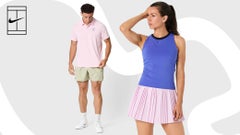Tecnifibre NRG2 vs. Babolat Xcel String Comparison
Both Tecnifibre NRG2 and Babolat Xcel have earned deserving reputations as two of the more comfortable and responsive tennis strings. Their comfort comes in no small part from their pliable construction. Both strings are packed with flexible fibers and infused with stretchy polyurethane. As a result they offer a level of arm-friendliness that is surpassed only by natural gut. In contrast to polyester strings (whose benefits accrue mostly to full swings), NRG2 and Xcel are responsive across slower strokes speed and touch shots. Granted, neither of these strings has the durability, spin and control found in polyester, but these downsides are not a problem for the player who craves comfort and power. Indeed, for the tennis player with a taste for fine multifilaments, the biggest problem with NRG2 and Xcel is deciding between them. To help with this decision we conducted a comprehensive playtest, comparing each string across several crucial categories. Here are the results.
TW University Data
 |
VS. |  |
| 158 | Stiffness | 151 |
| 18 | Tension Loss (%) | 19 |
| 3.2 | Spin Potential | 3.0 |
Stiffness
| Tecnifibre NRG2 16 | VS | Babolat Xcel 16 |
| ✓ | Power | |
| ✓ | Control | ✓ |
| ✓ | Comfort | ✓ |
If you want a general sense of how a string is likely to feel and play, a good place to start is with the stiffness value. A string's stiffness is the measure of how much it stretches at ball impact. Both NRG2 and Xcel have almost identical stiffness values, and they are among the "stretchiest" strings available. This means that they are softer and more forgiving than the majority of tennis strings on the market. It also means they are fairly powerful, especially compared to stiff polyester strings.
With so many similarities, are there any performance-based criteria for choosing between them? According to Chris, the answer is a definite yes. He explained, "Although both of these strings are known as soft playing multifilaments, there was a distinct difference in feel and performance on court. From the get-go Tecnifibre's NRG2 felt softer, livelier and more comfortable. On the flip side, Babolat's Xcel felt firmer, deader and more control oriented. I felt like I could take a bigger swing at the ball with Xcel, and at the start of the test I thought that one factor would make it the winner for me. However, the softer and plusher feel of NRG2 soon started to win me over. With its softer and more forgiving response I could string it tighter to get the same control as Xcel while still keeping a more responsive feel. Stringing Xcel lower gave it a more powerful feel but it never equaled the sweetness of NRG2."
Before selecting a winner for power and control, Tiffani was quick to point out the similarities between NRG2 and Xcel, especially in the comfort department. She said, "These strings are both great performers, and individually are worthy choices for those seeking a comfortable string setup that delivers a lively response. Comfort-wise, I found both of these strings to be standouts. I've dealt with wrist pain over the past few months, and the softer feel of both of these strings was a nice break from the stiffer poly strings."
As the playtest wore on, the superior playability and responsiveness of NRG2 was impossible for Tiffani to ignore. She continued, "The strings were neck and neck in terms of comfort, but NRG2 emerged as the front runner for me. NRG2 has a softer feel and seems to provide a little bit more power. The Xcel felt a little firmer or deader, which initially led to more control. However, as the string started to wear the control dipped. The added confidence that I had with NRG2 was the key factor for me when it came to control during points."
Spin
| Tecnifibre NRG2 16 | VS | Babolat Xcel 16 |
| ✓ | Spin | ✓ |
Unlike polyester strings, NRG2 and Xcel are not known for their spin potential. For starters, they lack the ultra low-powered response that enables the player to take explosive upward cuts at the ball, and they don't have the lethal bite you get with a Solinco Tour Bite or WeissCannon Ultra Cable. NRG2 and Xcel also lack the durable, low-friction coating that enables the strings to snapback powerfully during impact or withstand the violent sliding action of topspin mechanics. The good news is that because spin comes overwhelmingly from player mechanics, our crew managed to get decent spin from both.
Tiffani needed some time to figure out which of these multifilaments was more spin friendly, but eventually NRG2 emerged as the clear winner. She explained, "When the strings were fresh off the stringing machine I would have given the edge to Xcel. The more controlled response off the strings meant I could swing harder versus the livelier rebound off the NRG2. However, the Xcel stringbed started to get notched and stuck out of place very early on during the testing period. After that point NRG2 surpassed the Xcel for me on spin shots. The NRG2 didn't notch, move or fray for me until toward the end of the test so I got more consistent spin results throughout the duration of the playtest."
For Chris, the crucial variable for picking a winner in the spin department was control. He explained, "Out of the two strings NRG2 behaved like the more spin-friendly string, but I felt I got more spin with Xcel. Let me explain: NRG2 slid against itself better so it seemed like there was a better chance of getting some snapback to impart spin on the ball as it left the strings. I also got the sense NRG2 pocketed the ball better. However, the more controlled response of Xcel allowed me to take bigger cuts at the ball, which helped me get more spin on approach shots. I felt like I could swing faster to closer targets with Xcel, whereas I was holding back with NRG2 to tame its power. From the baseline things were more equal, but on the big points I still felt more comfortable swinging big with Xcel, and those bigger, faster swings helped me get more spin."
Feel
| Tecnifibre NRG2 16 | VS | Babolat Xcel 16 |
| Powerful / Soft / Plush / Connected | Chris | Comfortable / Deader, lower powered response |
| Soft / Lively / Muted | Tiffani | Clean / Deader |
With their multifilament constructions, NRG2 and Xcel are designed to feel soft and lively, especially when compared to a solid core nylon or monofilament polyester. Although NRG2 and Xcel have similar ingredients and are marketed to the same players, our crew detected some important differences in the way they felt at ball impact. Chris, who liked the feel of both, ultimately sided with the feel of NRG2. He said, "Both of these strings offered great feel, and I liked the way each string interacted with the ball. If I'd never hit NRG2 I would be very happy with the pocketing and soft feel of Xcel. However, when I was hitting the two strings side by side the softer and more responsive feel of NRG2 shone through. NRG2 just felt more elastic. With NRG2 it felt like the strings allowed the ball to sink deeper into the stringbed, increasing my connection to my shots.
Like Chris, Tiffani also discovered some differences in the way these two multifilaments felt and responded during play. She said, "NRG2 has a soft, somewhat muddy or cloudy feel at impact. The feeling is somewhat disconnected, but there's also a very lively response. Xcel feels cleaner and crisper at ball contact. I've said it feels 'deader,' which means I just felt like it is lower powered."
Tension Maintenance / Playability Duration
| Tecnifibre NRG2 16 | VS | Babolat Xcel 16 |
| ✓ | Tension Maintenance | |
| ✓ | Playability Duration |
There is no denying it. All tennis strings lose their original playability over time. The most common problem that affects playability is tension loss. Once strings lose too much tension your racquet's feel and response changes, after which it becomes harder to control the ball. Another problem that affects playability, especially with multifilaments like NRG2 and Xcel, is string displacement. This happens when the strings get stuck out of position during ball impact, preventing them from snapping back and responding optimally.
The good news for NRG2 and Xcel is that they both held tension quite well, especially when compared to polyester strings. This explains why neither of our playtesters reported tension maintenance issues with either string. However, we did find that Xcel's surface deteriorated quicker and was more prone to notching, which meant it got stuck out of position more easily. This kind of thing not only leads to premature breakage, but it also compromises the overall performance. As a result, NRG2 emerged as the clear winner in the category of playability duration. Tiffani explained, "One common knock against multifilament strings is that they move out of position and get stuck. Tecnifibre has some magic sauce for NRG2 because it avoided this problem. I typically get 3-4 weeks from a full bed of multifilament before I snap the strings. It wasn't until about the fourth week that I noticed fraying on the NRG2 and some strings started getting stuck out of place. Xcel, on the other hand, began to notch and get stuck out of place within the first hour. I was straightening the strings a couple times per game."
For Chris, both of these multis held tension well. He commented, "In terms of how the strings felt and responded over time, I found both to last well. Over a 24-hour period Xcel lost more tension, but then stayed very stable for the duration of the test. NRG2 also remained stable after a smaller initial drop in tension." However, as Tiffani discovered, Xcel's surface was stickier and more susceptible to frictional wear, which meant the strings failed to snapback effectively. Chris explained, "The coating on Xcel was not as slick, so the strings got stuck out of position more. I was continually straightening strings in the racquet with Xcel in it. The racquet with NRG2 offered better snap back into its original position, and I only had to straighten after longer points. The surface of NRG2 also held up better, remained slicker longer and resisted fraying and notching better."
Overall Winner
| Tecnifibre NRG2 16 | VS | Babolat Xcel 16 |
| ✓ | Chris' Pick | |
| ✓ | Tiffani's Pick |
Selecting between two of the most comfortable strings ever made is no easy task. According to our team, there are good reasons to play with either NRG2 or Xcel. For example, Xcel is a solid option for the player who wants a comfort string with above average control. On the other hand, NRG2 is an obvious choice for those who want juicy power and longer lasting playability. Having said that, each player found it easy to pick an overall winner.
Chris definitely appreciated the spin and control he got from Xcel, but the longevity and responsiveness of NRG2 was simply too hard to ignore. He explained, "I did not have a favorite between these two strings coming into the test. However, it didn't take long for it to become clear that NRG2 was my favorite of the two. I found more power with NRG2, it offered a plusher feel and I was more connected to the ball. Perhaps most importantly, NRG2 lasted longer. I did prefer the spin I got from Xcel, and I enjoyed its controlled response very much. If I'd never hit NRG2 side by side I would be perfectly happy with Xcel in my racquets. Xcel is a great playing string, but NRG2 outperforms it and holds up much better. In the end the winner became obvious; it was NRG2 all the way. "
As a multifilament player, Tiffani would happily play with both strings. However, like Chris, she could not resist the charms of NRG2. She explained, "I would be happy If I was given the chance to play with either of these stings. They are both outstanding options when it comes to comfort and easy playability. However, when pitted side by side, there is a clear winner for me, and that's NRG2. Although in the past I've not liked the rather soft feel of NRG2, I can get past that for the playability duration. It just has a more consistent lifecycle than Xcel. Xcel impressed me at the start, and I actually prefer the deader feel of Xcel overall, but it fell victim to the pitfall of softer strings and began to move and get stuck out of place more quickly than NRG2."
Article date: October 2017. If you found this article interesting or have further questions or comments please contact us.










